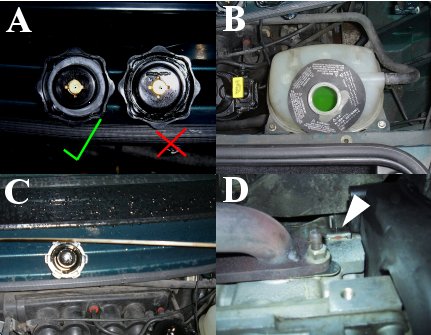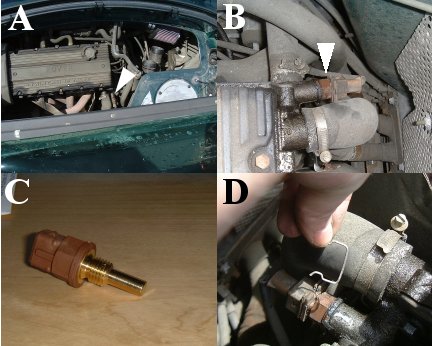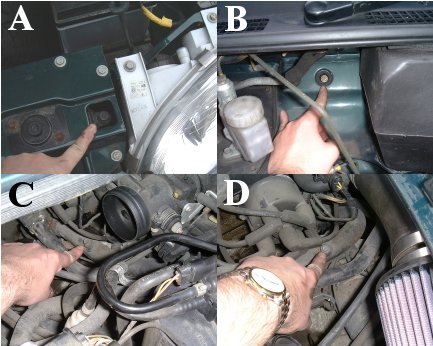Maintenance: diagnosis and prevention of HGF
- Problem: Steam is errupting from my car- what
is the cause?
- Action: stop as soon as is safe and practical.
Stop engine, and open the boot. Then as the engine cools, perform the following checks:
Look at the coolant expansion tank. Is there any coolant left? Is it boiling?
Is it Green?
If yes, then the steam erruption is likely to be due to a failure of
the coolant cap. To confirm, perform the following checks:
- Remove the Coolant cap and examine the brass valve. There is a rivet
which should be central. If it is not (as in A, the cap on the right),
the cap has failed. Replace.
- Check the coolant. The level should be above the minimum mark, and
the colour green (as pictured in 'B'). There should be no evidence of oil
or brown gunge. If the latter, then the head gasket has failed.
- Remove oil filer cap and dip stick (C). There should
be no evidence of a milky (mayo) residue- just oil. If present, the head gasket has
failed.
- Check under the car. If a pool of water, remove engine inspection
cover and look at the front right corner. If water is seen existing (arrowed, 'D')-
the head gasket has clearly failed.
|
Visual checks for
evidence of a HGF

Thanks to Jon Fredheim for the picture of the
failed head gasket (D).
(c)2001, Jon Fredheim |
| In the event of a head gasket failure, do
not attempt to drive the car any further. Arrange transportation to an MG/Rover dealership
or specialist for replacement. |
- Problem: my car is overheating in slow moving
traffic, but appears fine on the motorway.
- Action: Investigate as soon as practical-
overheating of aluminium engines is dangerous as it can lead to either premature head
gasket failure or damage/warping of the engine itself.
The most likely cause of a failure of this type is the malfunction
of the ECU temperature sensor or its electrical connection to the engine management
system. To check, open the engine inspection lid, and examine the following parts. A
replacement sensor (part # GTR206) costs less than 11 GBP including VAT, so replacement is
a sensible precaustion.
- Locate the ECU water temperature sensor- it is found on an elbow from
the cylinder head, arrowed in A and B. The housing is brown plastic.
- If replacement is planed, wait until engine is stone cold before
replacing sensor with a new item (pictured C).
- To remove electrical connector, carefully prise off the circlip, and
withdraw loom. If you wish to test function of the sensor in situ, run engine until warm
(water temp approx 80-90 celcius). Take multimeter, and measure electrical resistance
across the two terminals. It should be in the range of 300-400 ohms. If significantly
greater, then the sensor has failed and will require replacement. Replace when stone cold.
Unscrew and replace with new sensor sparingly smeared with a gasket compound.
|
Replacement of ECU
temp sensor

A: location of sensor at front left corner of
engine cylinder head (arrowed)
B: close up of sensor (brown coloured, arrowed).
C: what the sensor looks like (part #GTR206)
D: removing the wiring loom requires release of a
circlip- careful not to loose! |
Similar faults can occur with the dashboard temperature guage making
it under-read coolant temperature. Its location is immediately below the ECU temp sensor
mounted in the verticle plane.
Preventative Maintanence to avoid HGF
- As per hand book instruction, regularly check the level of coolant in
the expansion tank, topping up as necessary. Any rapid changes in level should arouse
concern.
- Keep an eye on the oil and water temperature guages. If any evidence
of overheating (or the engine behaving as though cold), then check the ECU temperature
sensor as described above.
- Check the condition of the water ways under the car- they are made of
steel, and can therefore rust- it is not unheard of for coolant to slowly leak away
because of corrosion of these pipes on cars of 3 years of age or more.
- If a pre-1998 MGF 1.8i, it is recommended to update the inlet
manifold seal with the later type. Early manifold seals are prone to premature
deterioration, and can be a cause of water loss and even precipitate a head gasket
failure.
- Ensure that the coolant is correctly bleed, and that the auto-bleed
valve is functioning correctly. Click here for
more information on this.
- ALWAYS avoid
over-revving the engine from cold: never exceed 3000 rpm until 60 celcius is showing on
the oil temp guage.
| There are three bleed nipples in the cooling system of
the MGF. One is located by the radiator (A), the heater (located on the front bulk head
behind the bonnet shroud, B) and in the engine bay, on the header rail, pictured from two
different angles (C, with filter removed observed from the luggage compartment & D
from inside the engine bay with inspection cover removed. The latter provides the easier
access). To bleed the system of air, keep the resevoir topped
up with coolant (50:50 water and Unipart Super3 antifreeze) and individually remove the
bleed screws one by one to release any trapped air. Drive the car a short distance, and
repeat again once the engine is cold. |
Location of the Bleed
Nipples

|
A potential solution to the HGF problem?
Another potential cause of the HGF problem has come to light as a
result of MGF related motorsports. Basically, from what I gather, the problem is as
already been highlighted on the MGF BBS, namely that due to the remote nature of the
radiator causing larger than 'normal' [than that found in FWD applications] changes in
coolant temperature entering the engine. This causes the standard type thermostat to
occasionally be fooled and close when the engine is actually hot, thus allowing localised
'micro' overheating. This phenomena, over a period of time, may weaken the perfectly good
head gasket leading to failure.
The common solution, apparently, is to drill four equi-spaced 6 mm holes in the thermostat
ring. This mod allows the cooling system to continue to function in a normal fashion, but
crucially also some circulation when the thermostat is shut. Thus, when the thermostat is
inappropriately shut, some cooling circulation continues avoiding the excess oscillations
of temperature caused by a negative-feedback system such as this with a remote effector
system.
There is a draw back- the warm up time is increased. It has been suggested to me that a
compromise for a road car would be one (or possibly two) 6 mm holes- which would result in
a slower warm-up time, but still adequate closed-thermostat circultion to prevent a
temperature peaks causing head gasket failure.
Thermostat modification: see Dieter's thermostat site.
If your MGF has ever suffered from a head gasket failure, we
would very much appreciate it if you could enter as many details as possible into our HGF
listing. From this we hope to learn more about the causes of the HGF, and help prevent
them occuring in the future- thankyou. Enter http://www.shame.4mg.com
here.



